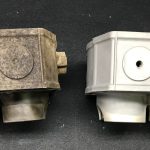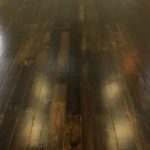The last thing a homeowner wishes for is to walk into their home only to realize they are standing in a puddle of water. Standing water throughout any part of your house can be both dangerous and costly to repair. Finding the source of the standing water can prove to be a nuisance. Is the water seeping through the floor? Or is it actually dripping rapidly from the ceiling?
The dangers and severity of standing water in your home
Standing water is dangerous because of all of the electrical components that exist within the walls of your home. If enough water is present, there is a chance for electrocution and it can short out your electrical systems. Therefore it is necessary to have a licensed and trained electrician assure you that the electricity has been cut off from the home. Additionally, depending on how long the water has been on the floor, it can cause severe water damage, mold and mildew growth, destroy your drywall, and cause wood to warp. If lingering for too long, your flooring will be ruined regardless of it being wood, carpet, or tile. The water can even cause the glue on the tiles to be destroyed. Ridding your home of mildew and mold can prove to be quite a task and often times means replacement of the floors. If you have wood floors the water can damage them so badly by creating a black in the color finish if the water seeps in deep enough. If the standing water comes from the floor then you know the water cut through the entire piece of wood. If not caught very quickly, there will be no chance of repairing the hardwood floor.
Another reason water seeping through the floors is such a serious issue is if you have a two story home or live in a multi-level apartment complex. The standing water can cause the flooring and sheetrock below to be compromised and it could collapse altogether. For this reason, a professional should scope out the situation before you enter freely if you do in fact live in a multi-level establishment.
It is crucial to act fast to salvage as much as you can of your flooring and your home altogether.
Step one: Where is the water coming from? Where is the leak?
Time to investigate! Before you can repair the leak, you must stop the leak, and before you can stop the leak, you must find it. Water damage through the ceiling is somewhat common in Florida so your Sarasota home very well may have a leak somewhere in it. Again, many people think that standing water is due to it coming through the floor and while it might have, you must also check the ceiling. So first, look for any signs on the ceiling for water damage. This could be in the form of a wet spot, a stain, or perhaps even the leak itself. Check your entire ceiling, not just the surrounding area of the biggest water pool. The leak in the ceiling could be anywhere.
Next…
You should check your plumbing for any visible signs of leakage. You can start by looking around your toilets, under your sinks, and in the bath/shower. Leaking pipes often project a strange hollow, hissing sound. Listen carefully for this noise because if you detect it, it can lead you right to the source of the leak. Be sure to especially check the kitchen as there are many water sources and water pipes in that room.
If there are no signs of leaks in the ceiling or in any other the water sources throughout your home, the conclusion is assumed to be a leak under the floor. Begin by inspecting the floor as well as you can. This will be contingent on just how much water has accumulated. If at any point you notice a bulge in the flooring of your home, it is safe to say you have found the source of where the water is coming from as this is an indicator.
The next thing you can do is use the “check your water meter” method as suggested by EPA.gov. With this, you simply turn all of your water sources off so that the home is not using a single ounce of water. Then you check your water meter. Wait 2-3 hours and check the meter again. If the meter displays that you have used water at this point, then you know there is a leak in the home somewhere. Contrarily if the water meter has not moved then you know the water leak is coming from an outside source.
Step two: Find a way to stop the leak
If you prove the standing water is a result of a leak within the home, then you will need to quickly shut off the water source to the home. If you find the leak to be in a specific pipe then shut the water off to that pipe. Stopping the flow of water will at least prevent more water from escaping from the source. This can also allow some of the excess water to drain off.
If the meter did not prove the water leaking was from a pipe or other indoor source, turning off the water to the home will not affect it or stop it. Common causes are leaks in the ceiling or a crack in the exterior of the home which both permit water to enter. In these cases, you will want to plug the problem right away if possible and then repair it immediately. The plug is temporary and intended to act as a band aide for the time being.
If the water is seeping up through the floor, it could be a result of insufficiently-sealed foundations or there could be cracks in the foundation floor.
Step three: Dry out your home
The first step in drying out your home is to make sure the humidity in the room is not too high, the temperature is low, and the air is circulating. Utilizing box fans, ceiling fans and open windows (given that it is not hot and/or humid outdoors) are all good ideas. This will help remove the water vapor and will in turn fuel the process of drying the home.
You will want to remove any objects affected by the water leak. Whether you can salvage them or not you need to remove them right away. The items that can be dried and saved should be put in direct sunlight. This will speed the drying. You do not want any wet furniture to be left in the house for an extended period of time as it become breeding grounds for mold and mildew. Remember that mold and mildew can bloom within 24-36 hours so this step is crucial.
Depending on the depth of the standing water you may want to utilize a wet vacuum to suck up the bulk of the water. Note that regular vacuums are not equipped to hand water removal and using one for such can be very dangerous. Once the water is at a minimum you can use a mop to soak up much of the remainder.
Step Four: Water leak prevention
Congratulations! You have found the leak, stopped it and repaired it. In an effort to prevent future leaks, you can have your pipes inspected by plumbers to be sure they are all remaining strong and are functioning correctly. Also, having your foundation and the exterior of your home inspected can be a good routine to check for cracks.











